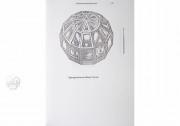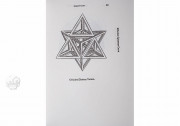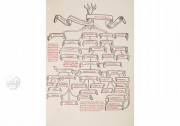The conclusion of the writing of the text took place in Milan in 1498. The author, the Franciscan Luca Pacioli (1445-1514), also known as Lucas de Borgo Sancti Sepulchri, taught mathematics in several Italian cities.
Paganini was also Paganino who printed other works, deserving special mention Somma di arithmetica, geometry, and proporzionalità proporzioni, in 1494, in Venice, which encapsulates the knowledge of the time and other personal papers, covering arithmetic , algebra, geometry and double-entry book-keeping. Note that his treatise on algebra paper is the first contribution on the subject and his treatise on the practical application of accounting is today an invaluable source of information on the commercial uses of the XV century.
Coinciding with the release year of Divina proportione logically in the workshop of Paganini, father and son, was born an edition prepared by him Elementa of Euclid.
The Divina proportione was written in Milan, at the court of Duke Ludovico Sforza, whom the work is dedicated, as it was the Duke himself who recommended preparation for a scientific duel strength held in Milan with the assistance of all kinds of ecclesiastical and secular authorities.
As the accompanying chart to work, Leonardo da Vinci made a pioneering collection of drawings of regular solids in perspective.
The prints, along with the use of round types, cursive and Greeks, many woodcut initials in various sizes, with white filigree chapter on dotted background, and alternating red and black ink on the title and the representation in the rectum of the last leaf, "Arbor proportio et proportionalitas" make the issue a delight for the eyes of the bibliophile, the scholar and who feels any curiosity about printed books.
The work, which acts as scientific editor Antonio Capella, consists of three parts.
A first in proposing to clarify the terms matematica and disciplinas matematicas, to include the perspective, architecture and cosmography, extending the classical division of the cuadrivium (arithmetic, geometry, astronomy and music), and in which, using intensively the Elements Euclid, aims to clarify how to understand the proportion.
A second part which is a treatise on the five regular solids (tetrahedron, hexahedron or cube, octahedron, dodecahedron and icosahedron) and its relationship to the divine proportion, some scholars have considered playing another person's work, the Libellus of quinque corporibus regolaribus Piero della Francesca.
Close the book, as third party, a small treatise on architecture.
The copies of the editions of Pacioli's work will always have a place in any exhibition of old books Math. and Architecture. As written by Antonio M. Gonzalez in the introduction to the edition of the work of Fra Luca Pacioli da Borgo Sansepolcro in 1991 (Torrejón de Ardoz: Akal): the whole course of the Divine proportion could be summarized in a single proposal: the architecture (like all art) should reflect, as "allo Specchio" the mathematical structure of the universe. The mathematical proportion, universal principle and objective beauty, should become a point of reference for all art (p. 25).
We have 1 facsimile edition of the manuscript "Madrid On Divine Proportion": Divina proportione : Opera a Tutti Glingegni Perspicaci e Curiosi Necessaria. Ove ciascun studioso... (About the Divine Proportions) facsimile edition, published by Vicent Garcia Editores, 2013
Request Info / Price



